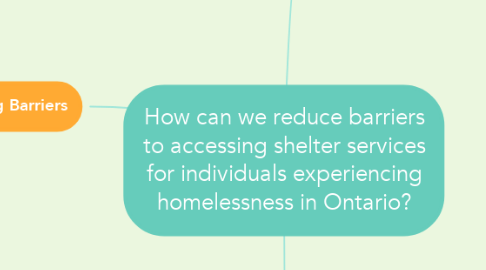
1. Existing Barriers
1.1. Systemic Problems
1.1.1. Lack of available transportation to shelters that are not centrally located
1.1.1.1. Some shelters are not easily accessible by bus and/or individuals may not have the financial capacity to attend the shelter
1.1.2. Individuals are unable to find out about bed availability without phoning/attending the shelter and are unable to reserve their bed without physically attending the shelter
1.1.2.1. individuals have to choose between doing meaningful activities during the scheduled check-in time and reserving their bed
1.1.3. Overcrowding
1.1.3.1. When shelters are overcrowded they become less comfortable and increase risks related to shelter access such as spread of illnesses and violence
1.1.4. Lack of bed availability
1.1.4.1. A shortage of family shelters specifically results in many families having to separate if they wish to stay in the shelter system
1.1.4.2. A chronic shortage of beds leads individuals to resort to other living arrangements (i.e. couch surfing or sleeping roug)
1.2. Policy Barriers
1.2.1. Policies that require trans individuals to stay in shelters that align with their birth sex are discriminatory and put them at increased risk for violence
1.2.2. Curfews and mandatory check-in times
1.2.2.1. Individuals who cannot make it by the curfew time each night can be turned away
1.2.3. Zero tolerance substance use policies enforced at some shelters prevent individuals from accessing them or result in them being barred from accessing the service
1.3. Individual experiences
1.3.1. Experiences of violence in shelter
1.3.2. Experiences of theft in shelter system
1.3.3. Fear of pests (i.e. bedbugs)
1.3.4. Potential for spread of illnesses in the shelter system
2. Systemic Solutions
2.1. Improve system capacity
2.1.1. Increase the physical number of shelter beds
2.1.2. Improve the accessibility for underserved populations, including families and youth, by increasing shelters designed to serve these populations
2.2. Improve access to housing options (emergency and long term) to reduce the stress on the shelter system
2.3. Improve transportation for shelters that are not easily accessed currently
2.3.1. Provide transportation to these shelters (i.e. by van)
2.3.2. Offer financial support to individuals accessing by public transit who may not be able to afford it currently
2.4. Improve accessibility to intake/reservation processes
2.4.1. Create an online system to access information about bed availability and check in so that these can be done remotely
2.4.2. Allow for intake to be done over the phone/in advance so that individuals who are not available/unable to attend in person during the scheduled times may have equity in access
2.5. Educate shelter staff
2.5.1. Education on Harm Reduction
2.5.2. Nonviolent crisis intervention training
2.5.3. Anti-oppressive approaches and trauma-informed care training
